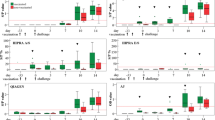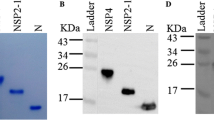Abstract
Porcine reproductive and respiratory syndrome is caused by the PRRS virus (PRRSV), which has six structural proteins (GP2, GP3, GP4, GP5, M and N). GP5 and N protein are important targets for serological detection by enzyme-linked immunosorbent assay (ELISA) and other methods. Toward this goal, we developed an indirect ELISA with recombinant GP5 antigens and this method was validated by comparison to the LSI PRRSV-Ab ELISA kit. The results indicated that the optimal concentration of coated recombinant antigen was 0.2 μg/well for a serum dilution of 1:40. The rate of agreement with the LSI PRRSV-Ab kit was 88.7% (266/300). These results support the potential use of recombinant GP5 as an antigen for indirect ELISA to detect PRRSV antibodies in pigs.
Similar content being viewed by others
References
Ansari I H, Kwon B, Osorio F A, et al. 2006. Influence of N-linked glycosylation of porcine reproductive and respiratory syndrome virus GP5 on virus infectivity, antigenicity and ability to induce neutralizing antibodies. J Virol, 80: 3994–4004.
Bakheit M A, Schnittger L, Salih D A, et al. 2004. Application of the recombinant Theileria annulata surface protein in an indirect ELISA for the diagnosis of tropical theileriosis. Parasitol Res, 92: 299–302.
Chen J, Liu T, Zhu C G, et al. 2006. Genetic variation of Chinese PRRSV strains based on ORF5 sequence. Biochem Gen, 44: 425–435.
Gao Z Q, Guo X, Yang H C. 2004. Genomic characterization of two Chinese isolates of porcine respiratory and reproductive syndrome virus. ArchVirol, 149: 1341–1351.
Hill H. 1990. Overview and history of mystery swine disease (swine infertility and respiratory syndrome). In: Proceedings of the Mystery Swine Disease Communication Meeting. Denver, CO, p 29–31.
Murtaugh M P, Elam M R, Kakach L T. 1995. Comparison of the structural protein coding sequences of the VR-2332 and Lelystad virus strains of the PRRS virus. Arch Virol, 140: 1451–1460.
Polson D D, Marsh W E, Dial G D. 1992. Financial evaluation and decision making in the swine breeding herd. Veterinary Clinics of North America Food Animal Practice, 8: 725–747.
Wissink E H, van Wijk H A, Kroese M V, et al. 2003. The major envelope protein, GP5, of a European porcine reproductive and respiratory syndrome virus contains a neutralization epitope in its N-terminal ectodomain. J Gen Virol, 84: 1535–1543.
Wu R, Hu S, Xiao Y, et al. 2007. Development of indirect enzyme-linked immunosorbent assay with nucleoprotein as antigen for detection and quantification of antibodies against avian influenza virus. Veter Research Commun, 31: 631–641.
Author information
Authors and Affiliations
Corresponding author
Additional information
Foundation item: Specific public service sectors of agriculture research (200803020).
Rights and permissions
About this article
Cite this article
Chen, Y., Tian, H., He, JH. et al. Indirect ELISA with recombinant GP5 for detecting antibodies to porcine reproductive and respiratory syndrome virus. Virol. Sin. 26, 61–66 (2011). https://doi.org/10.1007/s12250-011-3154-9
Received:
Accepted:
Published:
Issue Date:
DOI: https://doi.org/10.1007/s12250-011-3154-9




